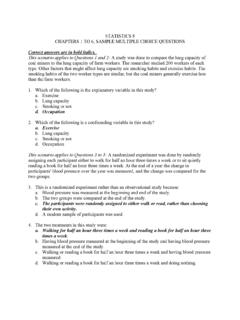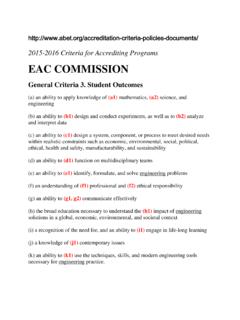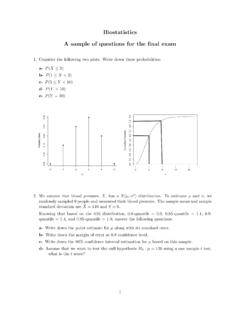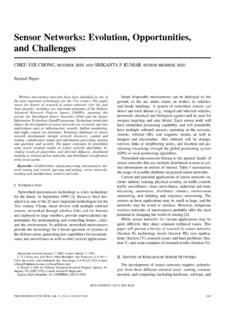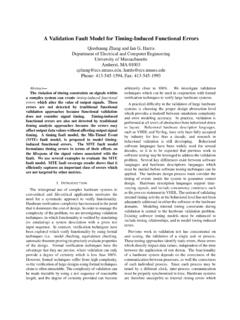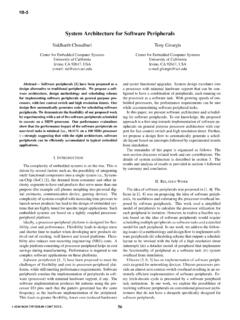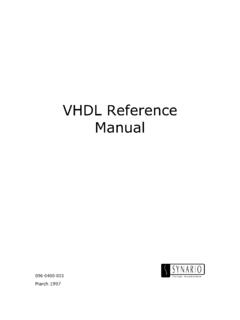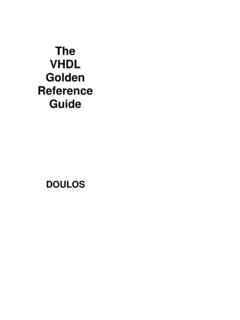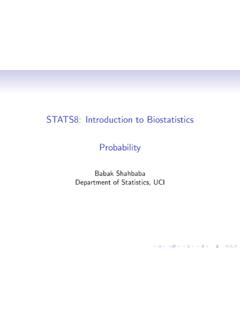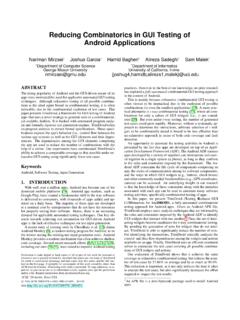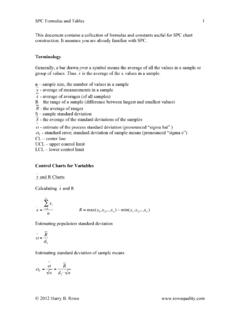Transcription of Analysis of Algorithms
1 Analysis of Algorithms Algorithm Input Output 2015 Goodrich and Tamassia 1 Analysis of Algorithms Presentation for use with the textbook, Algorithm Design and Applications, by M. T. Goodrich and R. Tamassia, Wiley, 2015 Scalability q Scientists often have to deal with differences in scale, from the microscopically small to the astronomically large. q Computer scientists must also deal with scale, but they deal with it primarily in terms of data volume rather than physical object size. q Scalability refers to the ability of a system to gracefully accommodate growing sizes of inputs or amounts of workload. 2015 Goodrich and Tamassia Analysis of Algorithms 2 Application: Job Interviews q High technology companies tend to ask questions about Algorithms and data structures during job interviews. q Algorithms questions can be short but often require critical thinking, creative insights, and subject knowledge.
2 N All the Applications exercises in Chapter 1 of the Goodrich-Tamassia textbook are taken from reports of actual job interview questions. 2015 Goodrich and Tamassia Analysis of Algorithms 3 xkcd Labyrinth Puzzle. Used with permission under Creative Commons License. Algorithms and Data Structures q An algorithm is a step-by-step procedure for performing some task in a finite amount of time. n Typically, an algorithm takes input data and produces an output based upon it. q A data structure is a systematic way of organizing and accessing data. 2015 Goodrich and Tamassia Analysis of Algorithms 4 Algorithm Input Output Analysis of Algorithms 5 Running Time q Most Algorithms transform input objects into output objects. q The running time of an algorithm typically grows with the input size. q Average case time is often difficult to determine.
3 Q We focus primarily on the worst case running time. n Easier to analyze n Crucial to applications such as games, finance and robotics 020406080100120 Running Time1000200030004000 Input Sizebest caseaverage caseworst case 2015 Goodrich and Tamassia Analysis of Algorithms 6 Experimental Studies q Write a program implementing the algorithm q Run the program with inputs of varying size and composition, noting the time needed: q Plot the results 2015 Goodrich and Tamassia 0100020003000400050006000700080009000050 100 Input SizeTime (ms) Analysis of Algorithms 7 Limitations of Experiments q It is necessary to implement the algorithm, which may be difficult q Results may not be indicative of the running time on other inputs not included in the experiment. q In order to compare two Algorithms , the same hardware and software environments must be used 2015 Goodrich and Tamassia Analysis of Algorithms 8 Theoretical Analysis q Uses a high-level description of the algorithm instead of an implementation q Characterizes running time as a function of the input size, n q Takes into account all possible inputs q Allows us to evaluate the speed of an algorithm independent of the hardware/software environment 2015 Goodrich and Tamassia Analysis of Algorithms 9 Pseudocode q High-level description of an algorithm q More structured than English prose q Less detailed than a program q Preferred notation for describing Algorithms q Hides program design issues 2015 Goodrich and Tamassia Analysis of Algorithms 10 Pseudocode Details q Control flow n if.
4 Then .. [else ..] n while .. do .. n repeat .. until .. n for .. do .. n Indentation replaces braces q Method declaration Algorithm method (arg [, ]) Input .. Output .. q Method call method (arg [, ]) q Return value return expression q Expressions: Assignment = Equality testing n2 Superscripts and other mathematical formatting allowed 2015 Goodrich and Tamassia Analysis of Algorithms 11 The Random Access Machine (RAM) Model A RAM consists of q A CPU q An potentially unbounded bank of memory cells, each of which can hold an arbitrary number or character q Memory cells are numbered and accessing any cell in memory takes unit time 0 1 2 2015 Goodrich and Tamassia Memory CPU Analysis of Algorithms 12 Seven Important Functions q Seven functions that often appear in algorithm Analysis : n Constant 1 n Logarithmic log n n Linear n n N-Log-N n log n n Quadratic n2 n Cubic n3 n Exponential 2n q In a log-log chart, the slope of the line corresponds to the growth rate 1E+01E+21E+41E+61E+81E+101E+121E+141E+16 1E+181E+201E+221E+241E+261E+281E+301E+01 E+21E+41E+61E+81E+10nT(n)CubicQuadraticL inear 2015 Goodrich and Tamassia Functions Graphed Using Normal Scale 2015 Goodrich and Tamassia 13 Analysis of Algorithms g(n) = 2n g(n) = 1 g(n) = lg n g(n) = n lg n g(n) = n g(n) = n2 g(n) = n3 Slide by Matt Stallmann included with permission.
5 Analysis of Algorithms 14 Primitive Operations q Basic computations performed by an algorithm q Identifiable in pseudocode q Largely independent from the programming language q Exact definition not important (we will see why later) q Assumed to take a constant amount of time in the RAM model q Examples: n Evaluating an expression n Assigning a value to a variable n Indexing into an array n Calling a method n Returning from a method 2015 Goodrich and Tamassia Analysis of Algorithms 15 Counting Primitive Operations q Example: By inspecting the pseudocode, we can determine the maximum number of primitive operations executed by an algorithm, as a function of the input size 2015 Goodrich and Tamassia Analysis of Algorithms 16 Estimating Running Time q Algorithm arrayMax executes 7n - 2 primitive operations in the worst case, 5n in the best case. Define: a = Time taken by the fastest primitive operation b = Time taken by the slowest primitive operation q Let T(n) be worst-case time of arrayMax.
6 Then a(5n) T(n) b(7n - 2) q Hence, the running time T(n) is bounded by two linear functions 2015 Goodrich and Tamassia Analysis of Algorithms 17 Growth Rate of Running Time q Changing the hardware/ software environment n Affects T(n) by a constant factor, but n Does not alter the growth rate of T(n) q The linear growth rate of the running time T(n) is an intrinsic property of algorithm arrayMax 2015 Goodrich and Tamassia Why Growth Rate Matters 2015 Goodrich and Tamassia 18 Analysis of Algorithms Slide by Matt Stallmann included with permission. if runtime for n + 1time for 2 ntime for 4 nc lg nc lg (n + 1)c (lg n + 1)c(lg n + 2)c nc (n + 1)2c n4c nc n lg n~ c n lg n + c n2c n lg n + 2cn4c n lg n + 4cnc n2~ c n2 + 2c n4c n216c n2c n3~ c n3 + 3c n28c n3 64c n3c 2nc 2 n+1c 2 2nc 2 4nruntime quadruples when problem size doubles Analyzing Recursive Algorithms q Use a function, T(n), to derive a recurrence relation that characterizes the running time of the algorithm in terms of smaller values of n.
7 2015 Goodrich and Tamassia Analysis of Algorithms 19 Analysis of Algorithms 20 Constant Factors q The growth rate is minimally affected by n constant factors or n lower-order terms q Examples n 102n + 105 is a linear function n 105n2 + 108n is a quadratic function 1E+01E+21E+41E+61E+81E+101E+121E+141E+16 1E+181E+201E+221E+241E+261E+01E+21E+41E+ 61E+81E+10nT(n)QuadraticQuadraticLinearL inear 2015 Goodrich and Tamassia Analysis of Algorithms 21 Big-Oh Notation q Given functions f(n) and g(n), we say that f(n) is O(g(n)) if there are positive constants c and n0 such that f(n) cg(n) for n n0 q Example: 2n + 10 is O(n) n 2n + 10 cn n (c - 2) n 10 n n 10/(c - 2) n Pick c = 3 and n0 = 10 1101001,00010,0001101001,000n3n2n+10n 2015 Goodrich and Tamassia Analysis of Algorithms 22 Big-Oh Example q Example: the function n2 is not O(n) n n2 cn n n c n The above inequality cannot be satisfied since c must be a constant 1101001,00010,000100,0001,000,0001101001 ,000nn^2100n10nn 2015 Goodrich and Tamassia Analysis of Algorithms 23 More Big-Oh Examples q 7n - 2 7n-2 is O(n) need c > 0 and n0 1 such that 7 n - 2 c n for n n0 this is true for c = 7 and n0 = 1 q 3 n3 + 20 n2 + 5 3 n3 + 20 n2 + 5 is O(n3) need c > 0 and n0 1 such that 3 n3 + 20 n2 + 5 c n3 for n n0 this is true for c = 4 and n0 = 21 q 3 log n + 5 3 log n + 5 is O(log n) need c > 0 and n0 1 such that 3 log n + 5 c log n for n n0 this is true for c = 8 and n0 = 2 2015 Goodrich and Tamassia Analysis of Algorithms 24 Big-Oh and Growth Rate q The big-Oh notation gives an upper bound on the growth rate of a function q The statement f(n) is O(g(n))
8 Means that the growth rate of f(n) is no more than the growth rate of g(n) q We can use the big-Oh notation to rank functions according to their growth rate f(n) is O(g(n)) g(n) is O(f(n)) g(n) grows more Yes No f(n) grows more No Yes Same growth Yes Yes 2015 Goodrich and Tamassia Analysis of Algorithms 25 Big-Oh Rules q If is f(n) a polynomial of degree d, then f(n) is O(nd), , 1. Drop lower-order terms 2. Drop constant factors q Use the smallest possible class of functions n Say 2n is O(n) instead of 2n is O(n2) q Use the simplest expression of the class n Say 3n + 5 is O(n) instead of 3n + 5 is O(3n) 2015 Goodrich and Tamassia Analysis of Algorithms 26 Asymptotic Algorithm Analysis q The asymptotic Analysis of an algorithm determines the running time in big-Oh notation q To perform the asymptotic Analysis n We find the worst-case number of primitive operations executed as a function of the input size n We express this function with big-Oh notation q Example.
9 N We say that algorithm arrayMax runs in O(n) time q Since constant factors and lower-order terms are eventually dropped anyhow, we can disregard them when counting primitive operations 2015 Goodrich and Tamassia Analysis of Algorithms 27 A Case Study in Algorithm Analysis q Given an array of n integers, find the subarray, A[j:k] that maximizes the sum q In addition to being an interview question for testing the thinking skills of job candidates, this maximum subarray problem also has applications in pattern Analysis in digitized images. 2015 Goodrich and Tamassia Analysis of Algorithms 28 A First (Slow) Solution Compute the maximum of every possible subarray summation of the array A separately. 2015 Goodrich and Tamassia The outer loop, for index j, will iterate n times, its inner loop, for index k, will iterate at most n times, and the inner-most loop, for index i, will iterate at most n times.
10 Thus, the running time of the MaxsubSlow algorithm is O(n3). An Improved Algorithm q A more efficient way to calculate these summations is to consider prefix sums q If we are given all such prefix sums (and assuming S0=0), we can compute any summation sj,k in constant time as 2015 Goodrich and Tamassia Analysis of Algorithms 29 An Improved Algorithm, cont. q Compute all the prefix sums q Then compute all the subarray sums 2015 Goodrich and Tamassia Analysis of Algorithms 30 Analysis of Algorithms 31 Arithmetic Progression q The running time of MaxsubFaster is O(1 + 2 + ..+ n) q The sum of the first n integers is n(n + 1) / 2 n There is a simple visual proof of this fact q Thus, algorithm MaxsubFaster runs in O(n2) time 01234567123456 2015 Goodrich and Tamassia A Linear-Time Algorithm q Instead of computing prefix sum St = s1,t, let us compute a maximum suffix sum, Mt, which is the maximum of 0 and the maximum sj,t for j = 1.
